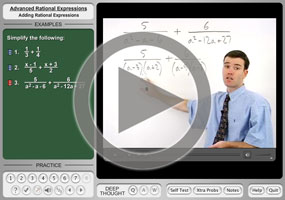Combining Rational Expressions: More Worked Examples
Purplemath
Thus far, all of the additions and subtractions of rational expressions have involved only two of these polynomial fractions. You may, however, be expected to combine three or more fractions.
If so, the process will be the same as previously, but we'll need more scratch paper.
Content Continues Below
Lots and lots of scratch paper...
- Simplify the following:
To find the common denominator, I'll first have to factor the quadratic in the third denominator:
x2 − 5x − 6
= (x − 6)(x + 1)
Fortunately for me, the quadratic denominator didn't introduce any new factors to the problem, so the common denominator will be (x − 6)(x + 1).
Since I was able to cancel out the x + 1 factor, I eliminated a zero from the denominator. Then my final answer is:
Affiliate
Can I reach inside the understood parentheses surrounding each of the numerator and denominator, and rip stuff out? Can I cancel the x's or cancel a 2 from each of the 4 and 6? No; never!
We can only cancel factors, not terms. Since the numerator and denominator share no *factors* in common, then there is nothing to simplify or cancel or otherwise do with the above answer. It is complete as it stands, and cannot be reduced any further.
Content Continues Below
- Simplify the following:
First I'll factor the quadratic in the third denominator:
x2 + 3x − 10
= (x + 5)(x − 2)
Affiliate
Advertisement
Note that these factors almost match the other denominators, but the second fraction's denominator is "backwards". How can I fix that? I can fix it by remembering the following:
5 − 3 = 2
3 − 5 = −2
The point of these two subtractions is that, when I reversed the subtraction, I got the same answer except for the sign. So I can reverse the subtraction in the second fraction's denominator, as long as I remember to also reverse the sign. This is what that looks like:
At the end, I factored the numerator, but nothing cancels out. So my answer is:
As you can see, I had to factor a denominator, multiply two of the fractions to get a common denominator, multiply those two fractions' numerators, add, simplify, and then factor again. You should expect to see some problems that are at least this involved. They're not so much complicated as they are long and annoying. Work them out step-by-step as I did above, and you'll get the right answers fairly regularly.
When you're adding and subtracting rationals, don't try to do a lot of steps in your head, or skip steps or do half-steps (like leaving out the denominators in your calculations), or you'll pretty much guarantee yourself the wrong answer. Take the time to do every step completely and carefully as you "practice" on the homework, so you have a good chance of getting these exercises right on the test.
URL: https://www.purplemath.com/modules/rtnladd3.htm
You can use the Mathway widget below to practice simplifying big, painful rational expressions. Try the entered exercise, or type in your own exercise. Then click the button and select "Simplify" to compare your answer to Mathway's.
Please accept "preferences" cookies in order to enable this widget.
(Click "Tap to view steps" to be taken directly to the Mathway site for a paid upgrade.)
Select a Course Below
Standardized Test Prep
Homeschool Math
© 2024 Purplemath, Inc. All right reserved. Web Design by ![]()




